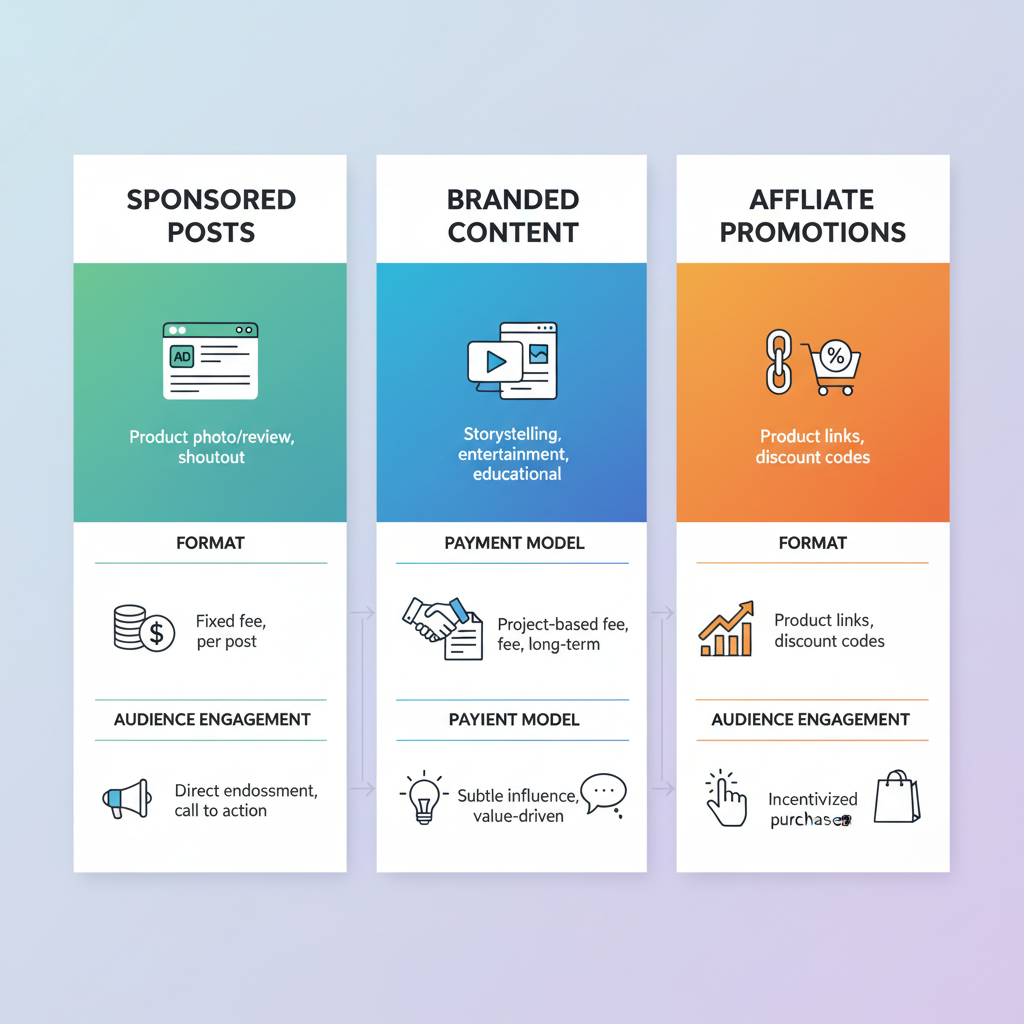Post Sponsoring Strategies for Brands and Creators
Learn effective post sponsoring strategies for brands and creators, from audience targeting to influencer selection and platform-specific tactics.

Understanding Post Sponsoring in Influencer Marketing
Post sponsoring in influencer marketing is a strategic collaboration where a brand compensates a content creator to share promotional posts on social media or other online platforms. This tactic enables companies to leverage the influencer’s established audience, credibility, and engagement to amplify authentic brand exposure. By sponsoring posts, brands can increase visibility, boost engagement, and drive conversions efficiently, while influencers monetize their influence.

---
Sponsored Posts vs. Branded Content vs. Affiliate Promotions
While these approaches share similarities, each serves distinct purposes within a content marketing strategy:
| Type | Description | Payment Structure | Disclosure Requirements |
|---|---|---|---|
| Sponsored Posts | Direct payment for a one-off or series of posts mentioning a brand or product. | Flat fee, CPM, or product exchange. | Mandatory FTC disclosure (#ad). |
| Branded Content | Creator collaborates with brand to produce content that reflects brand identity and values. | Typically higher rates due to creative input and production costs. | Platform-specific branded content tags, FTC compliance. |
| Affiliate Promotions | Creator earns a commission for sales generated through unique links or codes. | Performance-based; pay-per-sale or pay-per-click. | FTC requires disclosure for affiliate links. |
Understanding these distinctions is essential for choosing the most effective method to meet campaign goals.
---
Identifying Target Audience and Choosing Platforms
A successful post sponsoring strategy begins with defining your target audience. Consider:
- Demographics: Age range, gender, and location.
- Psychographics: Interests, lifestyle, and values.
- Behavior: Purchasing habits and preferred content types.
Once your audience is identified, select platforms that best reach them:
- Instagram: Ideal for visual storytelling in sectors like fashion, travel, and lifestyle.
- TikTok: Excellent for short, viral challenges targeting younger audiences.
- YouTube: Perfect for in-depth tutorials, reviews, and vlogs.
- Blogs: Powerful for SEO and evergreen, long-form content.

---
Researching Influencers Who Align with Brand Values
The right influencer choice can greatly impact the effectiveness of post sponsoring. Go beyond follower count to evaluate:
- Engagement rate: Organic interactions as a measure of audience connection.
- Content quality: Professionalism, creativity, and style consistency.
- Brand fit: Alignment of influencer’s values and niche with your brand identity.
Use tools like Upfluence or AspireIQ, or perform manual hashtag-based searches, to create a shortlist.
---
Setting Clear Campaign Objectives
Defining measurable objectives ensures strategic focus:
- Brand Awareness: Increase reach and impressions.
- Community Engagement: Achieve higher likes, comments, and shares on posts.
- Lead Generation: Gain new subscribers or app users.
- Sales Conversion: Drive direct product purchases.
Specific objectives guide campaign tactics, making performance tracking easier.
---
Determining Content Format and Messaging Guidelines
To ensure consistency while preserving authenticity:
- Select content type: Photo post, video, carousel, blog article.
- Outline messaging: Key messages, hashtags, and tone of voice guidelines.
- Define visual branding: Logo visibility, product placement, and usage demonstrations.
Provide clear brand requirements but maintain influencer creativity.
---
Negotiating Fair Compensation
Common payment structures in post sponsoring include:
- Flat Fee: One-off payment for agreed content deliverables.
- CPM (Cost Per Mille): Payment based on 1,000 impressions.
- Product Exchange: Non-cash incentives such as free products or services.
Align compensation with influencer reach, content effort, and campaign impact.
---
Compliance with FTC and Platform Rules
Transparency is vital for ethical and legal campaigns:
- Use clear disclosures like `#ad` or `#sponsored`.
- Apply platform-specific tags, e.g., Instagram’s “Paid partnership” label.
- On YouTube, check the “Includes paid promotion” option.
Non-compliance can result in credibility loss or fines.
---
Tracking KPIs for Post Sponsoring Campaigns
Track metrics that reveal the campaign’s performance:
| KPI | Definition | Why It Matters |
|---|---|---|
| Reach | Unique users who saw the sponsored content. | Indicates campaign visibility. |
| Engagement Rate | Interactions divided by reach or followers. | Reflects audience responsiveness. |
| CTR (Click-Through Rate) | Percentage clicking links in the sponsored post. | Measures ability to generate traffic. |
| Conversions | Number of desired actions completed. | Shows return on investment. |
---
Analyzing ROI and Optimizing Future Campaigns
Post sponsoring should be continually refined:
- Compare KPI results against set objectives.
- Identify high-performing content types.
- Assess influencer effectiveness for recurring partnerships.
- Reallocate budget to channels and creators delivering the strongest ROI.

---
Common Mistakes to Avoid
Brands often hinder campaigns by:
- Partnering with influencers who lack audience-brand alignment.
- Forgetting legal disclosure obligations.
- Over-controlling creative output.
- Skipping post-campaign performance analysis.
- Treating campaigns as isolated rather than long-term partnerships.
Avoid these pitfalls to maximize impact.
---
Examples of Successful Sponsored Collaborations
Industries have found success through platform-specific sponsorships:
- Beauty: Micro-influencers share Instagram Reels demonstrating skincare routines.
- Fitness: YouTube trainers integrate product mentions naturally into workouts.
- Tech: Bloggers publish detailed product reviews with affiliate links.
- Food: TikTok creators run taste-test challenges for restaurant chains.
These highlight creative adaptation and targeted execution.
---
Conclusion
Post sponsoring is an essential tool in influencer marketing, enabling brands to connect with audiences through authentic voices. By selecting aligned influencers, setting clear goals, offering creative freedom, and tracking performance data, businesses can run campaigns that boost awareness, engagement, and sales. Start refining your post sponsoring strategy today to unlock lasting brand growth.



